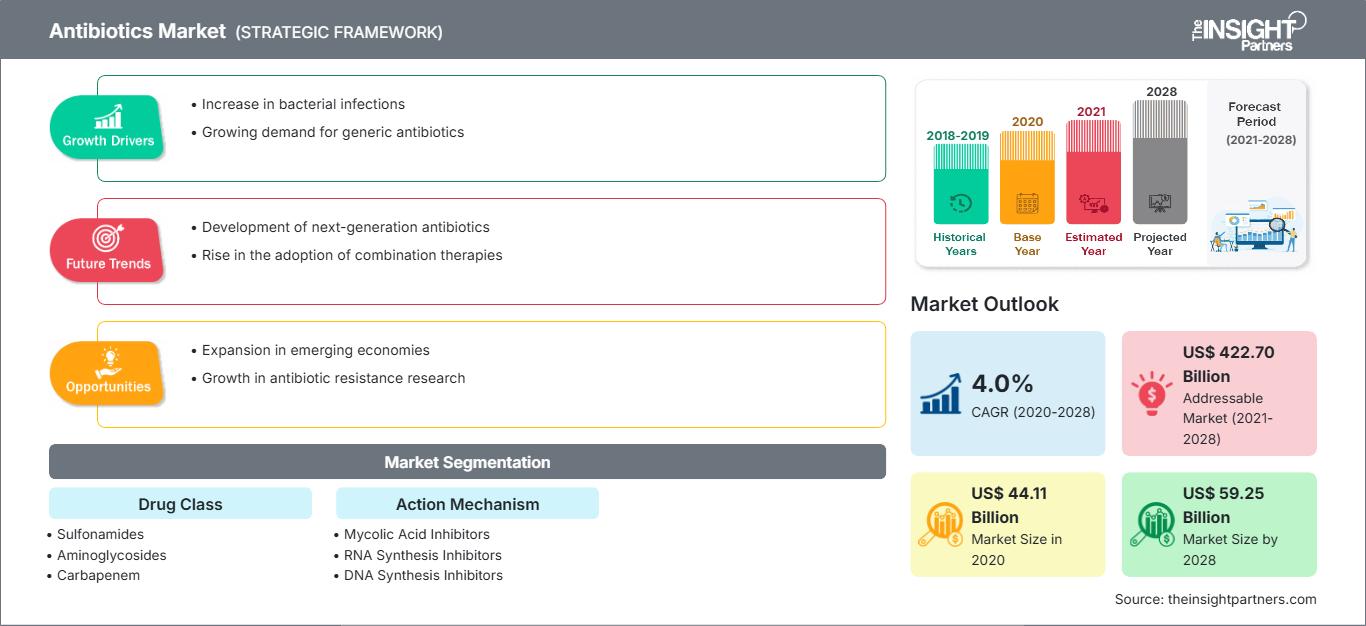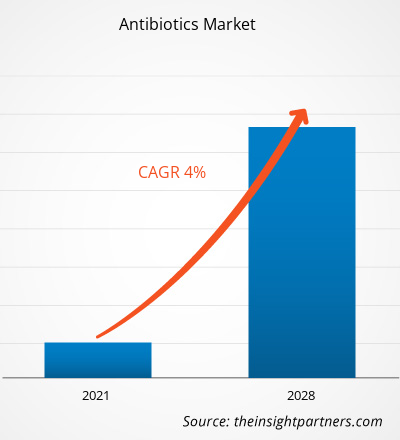Le marché des antibiotiques était évalué à 44 111,31 millions de dollars américains en 2020 et devrait atteindre 59 253,24 millions de dollars américains en 2028 ; il devrait croître à un TCAC de 4,0 % entre 2021 et 2028.
Les antibiotiques sont des médicaments puissants utilisés pour lutter contre les infections et les maladies bactériennes. Ils sont spécifiquement utilisés pour traiter les infections causées par des bactéries telles que Staphylococcus, Strep ou E. coli. Les antibiotiques tuent les bactéries (bactéricides) ou les empêchent de se reproduire et de se développer (bactériostatiques). Le marché des antibiotiques n'est efficace contre aucune infection virale. Certaines infections courantes traitées par antibiotiques sont la conjonctivite, les infections de la peau ou des tissus mous, les infections des voies respiratoires supérieures, la bronchite, la pharyngite streptococcique (angine streptococcique), entre autres.
Analyses du marché : Développement croissant des médicaments génériques
Un médicament générique est une copie d'un médicament de marque qui n'est plus sous brevet. Les versions génériques sont introduites sur le marché dans le but de proposer des médicaments rentables et d'accroître leur portée auprès de personnes appartenant à différentes classes sociales. Les versions génériques sont populaires en raison de leur disponibilité et de leur accessibilité. Par exemple, selon une étude publiée sur le NCBI en 2018, le prix moyen d'une ordonnance de marque était près de quatre fois supérieur au prix moyen d'un générique. De plus, les entreprises se concentrent également sur le développement de versions génériques afin de proposer des antibiotiques à des coûts minimes. Par exemple, en juin 2018, Lupin a lancé une solution d'inhalation générique de tobramycine sur le marché américain. De plus, les encouragements des autorités gouvernementales devraient également stimuler la production d'antibiotiques génériques, ce qui, à terme, stimulerait la croissance du marché des antibiotiques au cours de la période de prévision. Par exemple, en février 2019, la Food and Drug Administration (FDA) américaine a annoncé l'autorisation de commercialisation de médicaments génériques fabriqués par des laboratoires pharmaceutiques indiens aux États-Unis.
Vous bénéficierez d’une personnalisation sur n’importe quel rapport - gratuitement - y compris des parties de ce rapport, ou une analyse au niveau du pays, un pack de données Excel, ainsi que de profiter d’offres exceptionnelles et de réductions pour les start-ups et les universités
Marché des antibiotiques: Perspectives stratégiques

-
Obtenez les principales tendances clés du marché de ce rapport.Cet échantillon GRATUIT comprendra une analyse de données, allant des tendances du marché aux estimations et prévisions.
En fonction de la classe de médicaments, le marché des antibiotiques est segmenté en sulfamides, aminosides, carbapénèmes, macrolides, fluoroquinolones, pénicilline, céphalosporines, entre autres. Le segment des céphalosporines détenait la plus grande part de marché en 2020 ; tandis que le segment des fluoroquinolones devrait enregistrer le TCAC le plus élevé du marché au cours de la période de prévision.
Aperçu du mécanisme d'action
En fonction du mécanisme d'action, le marché des antibiotiques a été segmenté en inhibiteurs de l'acide mycolique, inhibiteurs de la synthèse de l'ARN, inhibiteurs de la synthèse de l'ADN, inhibiteurs de la synthèse des protéines et inhibiteurs de la synthèse de la paroi cellulaire. Le segment des inhibiteurs de la synthèse de la paroi cellulaire détenait la plus grande part de marché en 2020, tandis que celui des inhibiteurs de la synthèse de l'ADN devrait enregistrer le TCAC le plus élevé du marché au cours de la période de prévision.
Les lancements de produits et les stratégies d'approbation sont couramment adoptés par les entreprises pour étendre leur présence et leur portefeuille de produits à l'échelle mondiale et répondre à la demande croissante.
Les acteurs du marché des antibiotiques adoptent une stratégie d'expansion pour élargir leur clientèle à l'échelle mondiale, ce qui leur permet également de préserver leur image de marque à l'échelle mondiale. Par exemple, en juillet 2019, des entreprises comme Pfizer ont lancé un consortium de recherche international pour découvrir et développer de nouveaux antibiotiques contre la tuberculose, en collaboration avec huit partenaires biotechnologiques et des universitaires européens.
Aperçu régional du marché des antibiotiques
Les tendances régionales et les facteurs influençant le marché des antibiotiques tout au long de la période de prévision ont été analysés en détail par les analystes de The Insight Partners. Cette section aborde également les segments et la géographie du marché des antibiotiques en Amérique du Nord, en Europe, en Asie-Pacifique, au Moyen-Orient et en Afrique, ainsi qu'en Amérique du Sud et en Amérique centrale.
Portée du rapport sur le marché des antibiotiques
| Attribut de rapport | Détails |
|---|---|
| Taille du marché en 2020 | US$ 44.11 Billion |
| Taille du marché par 2028 | US$ 59.25 Billion |
| TCAC mondial (2020 - 2028) | 4.0% |
| Données historiques | 2018-2019 |
| Période de prévision | 2021-2028 |
| Segments couverts |
By Classe de médicaments
|
| Régions et pays couverts |
Amérique du Nord
|
| Leaders du marché et profils d'entreprises clés |
|
Densité des acteurs du marché des antibiotiques : comprendre son impact sur la dynamique des entreprises
Le marché des antibiotiques connaît une croissance rapide, portée par une demande croissante des utilisateurs finaux, due à des facteurs tels que l'évolution des préférences des consommateurs, les avancées technologiques et une meilleure connaissance des avantages du produit. Face à cette demande croissante, les entreprises élargissent leur offre, innovent pour répondre aux besoins des consommateurs et capitalisent sur les nouvelles tendances, ce qui alimente la croissance du marché.

- Obtenez le Marché des antibiotiques Aperçu des principaux acteurs clés
- Analyse historique (2 ans), année de base, prévision (7 ans) avec TCAC
- Analyse PEST et SWOT
- Taille du marché Valeur / Volume - Mondial, Régional, Pays
- Industrie et paysage concurrentiel
- Ensemble de données Excel
Rapports récents
Rapports connexes
Témoignages
Raison d'acheter
- Prise de décision éclairée
- Compréhension de la dynamique du marché
- Analyse concurrentielle
- Connaissances clients
- Prévisions de marché
- Atténuation des risques
- Planification stratégique
- Justification des investissements
- Identification des marchés émergents
- Amélioration des stratégies marketing
- Amélioration de l'efficacité opérationnelle
- Alignement sur les tendances réglementaires






















 Obtenez un échantillon gratuit pour - Marché des antibiotiques
Obtenez un échantillon gratuit pour - Marché des antibiotiques